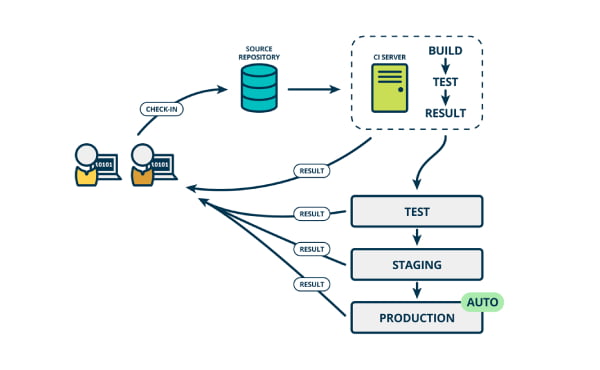What is CI/CD?
In the early days of software development, the ruling industrial process model used to be the renowned Waterfall Model. This model consists in a sequential set of steps each requiring their completion before the next –hence the name waterfall, thus ensuring they don’t overlap. In this way, the order of the process steps would be generally something like this:
- Requirement Analysis
- System Design
- Implementation
- Testing
- Deployment
- Maintenance
This sounds like pretty logical process phases; but, what if errors appeared on the implementation or design levels and developers kept pushing code into the repository? This will impact immediately on the integration phase, ensuing nothing but chaos in our project.
Continuous Integration
In the early 90s, a concept came through, called Continuous Integration (CI), which implies the following:
- Daily and continuous integration of updates into codebase, assuring a consistent, automated process of building, packaging, and testing of new software. Builds and merges are done repeatedly through the day, at a fast pace.
- Code changes are committed into a shared repository. This makes for small, easy to track updates. With every new integration, an automatic build-and-test sequence is triggered. A process which provides quick feedback and notification to the developing team.
Automatic builds spare the team from merge conflicts, bugs, and duplicate efforts, that’s why CI is ideal for complex, big scale projects.
Now, what about the CD part in CI/CD?
CD stands for Continuous Delivery. This succinctly means, delivering software in short, frequent cycles, ensuring it’s reliably tested –since it comes directly out of the integration phase– and ready for deployment, all in an automated way. It solves the problem of poor visibility and enhances the communication between the development and business teams. To that end, the purpose of continuous delivery is to ensure that it takes minimal effort to deploy new code. Software releases, by being smaller and more frequent, are less disruptive and easier to deal with, should any issue come up. Customer needs are better met, since CD allows rapid delivery of new features.
So, what do CI and CD do together?
CI/CD is essentially the combination of both practices, which are in such way transformed into a pipeline, normally called CI/CD Pipeline. The CI/CD pipeline then ensures continuous automation and monitoring throughout the software lifecycle, from integration and testing to delivery and deployment. This results in more testing –hence earlier detection of defects, more productivity and therefore faster releases. It shortens the distance between development and operation teams. CI/CD in this way constitutes itself as the methodological and strategic basis of modern day DevOps. CD refers also to Continuous Deployment, and it’s a concept often used interchangeably with Continuous Delivery since both relate to the automation of further stages of the pipeline. Continuous Deployment can also be thought of as the changes done by developers, which, being released automatically from repository to production, are ready for customer use. It accelerates software delivery by alleviating the operations team’s manual routines; a logical flow from Continuous Delivery which, by benefiting from it, automates the next stage in the pipeline.
Testing in the CI/CD Pipeline
When we think about the CI/CD pipeline, we should naturally imply the automation of testing to an important extent. Automated testing gives way to what is known today as continuous testing, which is defined as the testing that is performed repeatedly and frequently, with very little –ideally zero– human intervention. Because it tests along the release pipeline and not at the end of the development process –like in the waterfall methodology, this dynamic makes early fails possible, accelerating the process of bug finding/fixing, thus avoiding the chaos of building on top of broken code, reducing impact and costs in a notable, sensible manner.
In short, automated testing is an absolutely essential aspect of the CI/CD pipeline.
CI/CD with Autify
With the Autify API you can run tests in the CI/CD pipeline.
Autify facilitates integration with CI/CD tools such as CircleCI and Jenkins, and it can be included in the development flow, e.g., it can trigger a test plan when the code is merged. New features can be more safely and confidently released by running an Autify regression test automatically and prior to release, when the features are merged into the master/develop branch, whether in GitLab CI/CD or in CircleCI.
Last but not least; all this versatility and potential is bundled within a no code, AI powered, change-adaptable, self-maintaining, self-healing, platform.
A brief search online will show us a lot of options in this new world of no code platforms. But, when it comes to pricing, most of them aren’t exactly what we would deem transparent. Besides, real, comprehensive tech customer support is a value that differentiates a good tool/service from an average one.
We invite you to check these amazing customer stories:
- How Did Asoview Automate 200 Scenarios? ‘It Really Is a No-Code Testing Solution for Everyone!’
- Escaping the downward spiral of regression with Autify: from 40 hours of testing to zero using codeless test automation.
You can see other of our client’s success stories here: https://autify.com/why-autify
- Autify is positioned to become the leader in Automation Testing Tools.
- We got 10M in Series A in Oct 2021, and are growing super fast.
As said before, transparent pricing is key to our business philosophy.
At Autify we have different pricing options available in our plans: https://autify.com/pricing
- Small (Free Trial). Offers 400~ test runs per month, 30 days of monthly test runs on 1 workspace.
- Advance. Offers 1000~ test runs per month, 90~ days of monthly test runs on 1~ workspace.
- Enterprise. Offers Custom test runs per month, custom days of monthly test runs and 2~ workspaces.
All plans invariably offer unlimited testing of apps and number of users.
We sincerely encourage you to request for our Free Trial and our Demo for both Web and Mobile products.

